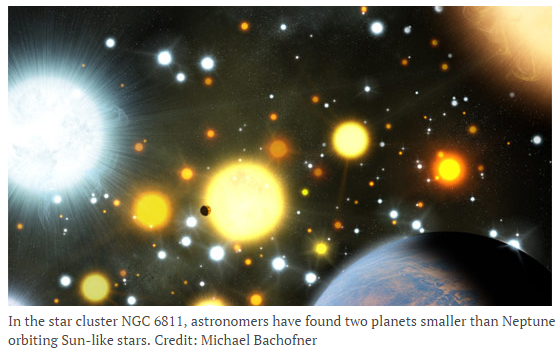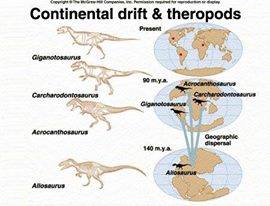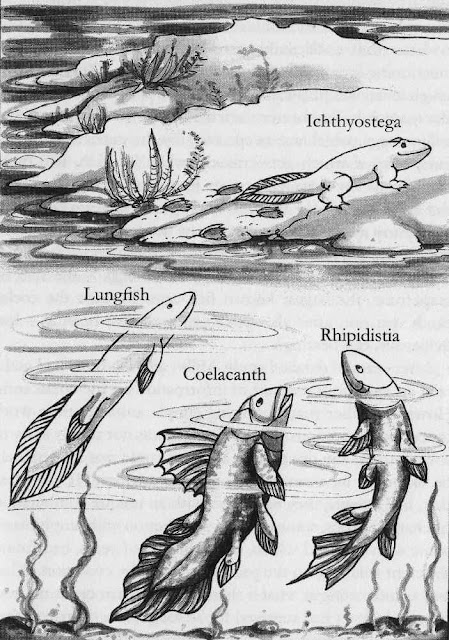why there are so many planets in the star clusters?
Researchers have many planets in stellar clusters.
The presence of more number of planets among stellar clusters has struck the science world with wonder.
A team headed by Dr. Soren Meibom of the Harvard Smithsonian Center for Astrophysics has discovered two Neptune-sized super-earths in the environment of an open star cluster called NGC 6811, located at three thousand light years from the earth.
Particularly, a planet revolving around a star named Kepler 66 is called 66b and a planet revolving around a star named Kepler 67 is called 66b.
These two stars are orbiting their own stars once in seventeen and fifteen days respectively.
These two planets and their stars were discovered based on the accurate measurement of the dimming of a star periodically as the orbiting planet passes between their stars and the earth (Transit Method).
Similarly, scientists have also discovered three stars in Messier-67, an open cluster located at two thousand five hundred light years from the earth, being orbited by three Jupiter-like planets.
These three planets were discovered by accurately measuring the slight wobble caused periodically by them in their stars due to the gravitational force (Wobble Method).
This study was headed by Dr. Roberto Sagila of Germany.
There are more than five hundred stars in the Messier Star cluster.
These three planets were discovered when Dr. Sagila’s team was continuously monitoring sixty-six Sun-like stars.
Dr. Sagila has stated that based on this, it has been found out that planets orbit five percent of the stars of this star cluster.
However, it is noteworthy that it has been discovered that only one percent of the single stars are being orbited by planets like Jupiter.
Why is it a wonder to find more number of planets in star clusters?
According to the currently accepted theory, when a giant molecular cloud in the space cooled, contracted, flattened and spun more rapidly due to the gravitational pull, Sun was formed in the bulky center of the cloud and the other planets and sub planets were formed when the disk got thinner and flatter and particles of dust and gases began to stick together to form clumps.
Particularly, the temperature near the Sun was very high and due to this reason, there was very less dust and gases near the Sun.
These gases and dust slowly stuck together and in the long run led to the formation of smaller rocky planets like Earth and Mars.
Likewise, it is believed that far away from the Sun, the temperature was very low and there existed a huge amount of dust and gases.
The dust and gases gathered on a massive scale led to the formation of bigger gaseous planets like the Saturn.
It is believed that it will take a long time for the planets to form in this way.
It may take a minimum of ten to one hundred million years for the planets to form in this way.
But, the studies conducted during the last sixty years have revealed the existence of billions of stars in the Milky Way alone.
Hence it is currently believed that planets may form by a very fast method that may take place in the space frequently.
Hence, it is believed that instead of clustering and clumping in due course, massive gaseous planets like the Jupiter and Saturn may form in a very short time by a sudden instability, in the gravitational force of the dust clouds.
But, it is also believed that calm environment is required for the planets to form by both the methods.
For example, our Sun is located very far from the other stars.
To be specific, the nearest star to our Sun is located at a distance of four light years.
Hence, it is a wonder that Jupiter-sized planets orbit stars that are among star clusters with closely located stars.
To be specific, the stars in the star clusters are found in places which are a hundred times smaller than the place where our stars like the Sun are located in the space.
So, there will be intense heat among these star clusters. Also, over the course of millions of years these stars will age and finally have an explosive death.
In addition, the gravitational pull of other stars close to a star will also be more.
Here, the unanswered question is, how planets were formed by the clumping of dust and gases in congested places like these?
But there is nothing to be surprised about.
This is because, planets are formed by the combination of heavy elements like oxygen, carbon, sodium, silicon, potassium, chlorine etc. formed by the nuclear reaction that takes place inside the stars.
When the gases on the periphery of the stars in this stage vaporize due to the heat generated by the nearby star, the planets formed inside the vaporizing star start orbiting the neighboring star.
This is the reason for the formation of planets near the stars that are located among the star clusters with a high temperature.




Comments